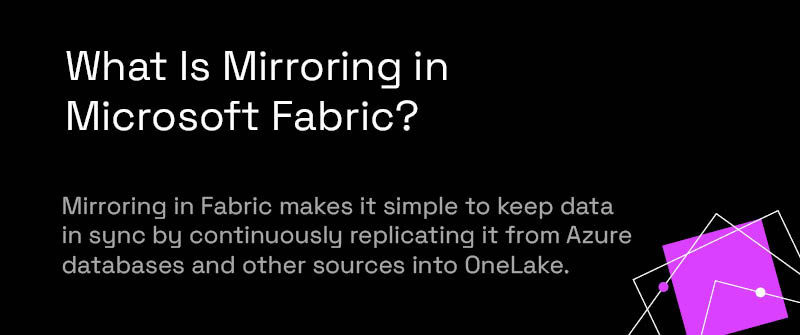
How Does Microsoft Teams Improve Collaboration?
Ever feel like your team’s communication is all over the place? Microsoft Teams brings everything together—chats, meetings, and files—all in one place. If your team is drowning in endless email chains and struggling to keep track of conversations, Microsoft Teams may just be your new best friend.
Teams plays a huge role in the Microsoft ecosystem, making collaboration easier across your business. Since everything is built on a shared foundation, users can easily share info, access files, and work across teams without constantly switching between apps or digging through emails. Microsoft Teams also integrates with Fabric to bring powerful data capabilities into the collaboration workflow. Here’s where the experts come in. Microsoft Fabric Consulting will help you set up and integrate Fabric with Teams and all the key players in the Microsoft ecosystem, empowering your business to stay ahead of the competition by helping eliminate data silos that limit collaboration.
Teams Features for Collaboration and Communication
Teams is much more than a chat app; it’s a central hub for communication and collaboration, a huge advantage in today’s hybrid work world. Whether you’re in sales, HR, or finance, Teams makes it easy to meet, message, call, and share files. With smooth integration across Microsoft 365 (as well as apps like PowerPoint and SharePoint), it keeps workflows smooth, makes data sharing easier, and helps everyone stay on the same page, no matter where they’re working. Let’s dig deeper:
- All-in-One Hub – Chat, video calls, file sharing, and app integrations—all in one place. No more app-hopping. Customize workspaces with apps, bots, and integrations to make Teams work exactly how your team needs it.
- Easy File Access – Pull up, edit, and share files right inside Teams, thanks to its deep integration with Microsoft 365.
- Instant Communication – Whether it’s a quick chat, a group thread, or an all-hands company video meeting, staying connected is easy.
- Built-in Collaboration – Work on documents together with real-time collaboration. No need to send endless email attachments.
- Secure & Organized – With permission controls and structured channels, the right people get access to the right info.
Basically, Teams collaboration keeps everything and everyone connected. Cross-department collaboration and communication that’s a breeze across your entire organization … sounds awesome, right?
Enhance Data Dynamics With Fabric and Teams
Microsoft Teams and Microsoft Fabric team up to make data easier to access, share, analyze, and act on. Instead of jumping between apps, you can pull actionable insights straight into Teams chats, channels, or meetings for easier collaboration and decision making. Here’s how they work together:
- Data Where You Need It – Fabric’s OneLake centralizes data so users can find, share, and work with the latest info in their Teams. Fabric also integrates with Power BI ,so you can pull your interactive dashboards and reports right into Teams chats and meetings.
- Seamless Collaboration – Share and add notes to reports and discuss insights to make decisions in Teams, all in real time—no more back-and-forth emails.
- Instant Alerts – Fabric Activator instantly notifies the right people in Teams when key data changes so they can act fast.
- AI-Powered Help – Copilot in Fabric can summarize trends, answer data questions, and even suggest next steps, all right inside your Teams chat.
The takeaway? Teams + Fabric = a data dream team that turns data into action, right where your team already works. Think about this example of cross-department collaboration success: Let’s say your company is launching a new product. Marketing, sales, and product teams can track key metrics in shared Fabric dashboards so everyone is aligned on market trends, sales pipelines, and product performance. Teams channels act as a central hub for updates, questions, and campaign planning (nothing gets lost in email threads). Plus, real-time data sharing ensures that decisions are based on the latest insights, leading to a smoother product launch.
How Does Microsoft Fabric Work?
Fabric’s architecture is all about simplifying and unifying data analytics and business intelligence. Instead of juggling multiple tools, Fabric brings everything into one unified platform for data ingestion, transformation, real-time analytics, and AI-powered insights. OneLake acts as a central data hub, storing your data sources and keeping it all organized and accessible.
Fabric brings everything together, Data Engineering, Data Factory, Data Science, and Real-Time Intelligence, so data moves smoothly from raw collection to business intelligence insights in Power BI. Its layered architecture keeps things flowing, while built-in AI and automation cut out busy work, break down silos, and help teams make faster decisions. Organizations can also establish data governance policies to maintain consistency, privacy, and control across departments.

What About Data Aggregation and Distribution?
Fabric simplifies data aggregation and distribution with tools like dataflows, data warehouses, and event streams to handle all types of data (historical, structured, or real-time). It streamlines how you collect, transform, and share data, empowering teams to access the right insights when they need them.
Dataflows are great for prepping and transforming data with a low-code interface, letting you filter, join, and aggregate information before pushing it to destinations like lakehouses for analysis. Data warehouses store structured data and support advanced queries, making them ideal for deeper insights and distribution to Power BI reports. Event streams ingest live data, process and aggregate it on the fly, and route it to the right locations—perfect for keeping dashboards and analytics up to date in the moment.
Real-time data sharing across departments? Sure, Microsoft Fabric ensures everyone works from the same up-to-date information. With event streams and OneLake, data flows instantly from one team to another. SSales tracking live revenue numbers, operations monitoring supply chain updates, or marketing analyzing customer trends are all covered with Fabric, empowering cross-department collaboration and instant reaction to identify trends.
And if you’re tired of waiting for manual updates or sifting through emails, your teams can access and collaborate on the same real-time dashboards and reports in Power BI and Microsoft Teams. This means faster decision-making, better alignment, and more efficient workflows.
Will Fabric Integrate With My Existing Tools?
Yes, Fabric is designed for easy integration, especially within the Microsoft ecosystem. It connects smoothly with tools like Dynamics 365, Azure Synapse Analytics, and Microsoft Power Platform tools like Power BI and Power Apps. Plus, Microsoft Teams integration with Fabric is key to real-time collaboration.
That said, while Fabric is designed to work seamlessly with Microsoft tools, it’s not limited to them. It also integrates with a range of third-party tools and frameworks. You can connect it with external analytics platforms and use popular open-source AI/ML frameworks like Python, R, and Spark. Plus, it offers APIs, data pipelines, and integration points to bring in other applications and tools. So, although Fabric is optimized for Microsoft users, it’s flexible enough to fit into diverse tech stacks.
What Are the Capabilities of Microsoft Fabric?
Fabric doesn’t just manage data, it unlocks its full potential by combining collaboration, AI, and streamlined data management. Our Fabric consultants can work with you to get the most out of everything Fabric has to offer. We can create customized solutions for various roles on your team, empowering users with the tools they need. Our Power BI experts will help you take advantage of Fabric’s integration with Power BI and Microsoft Synapse Analytics tools for analysis and visualization. With this dynamic team of tools, you’ll get deeper insights from data analytics for data-driven decision-making.
Fabric takes AI and machine learning to the next level, making it easier for teams to work with data without needing a PhD in data science. With Copilot, you can use natural language to describe what you need, and it can help you generate SQL queries, build data pipelines, and even refine machine learning models. Fabric Data Science also integrates with Azure Machine Learning, so data scientists can manage models and turn raw data into real predictions. The best part? Those AI-driven insights can be plugged right into Power BI, helping businesses move from analyzing past trends to predicting what comes next.
Microsoft Fabric (similar to Power BI’s consistent updates) keeps evolving, adding new features to make cross-department collaboration, data exploration, modeling, and development even better. The recent updates below are an example of Microsoft’s commitment to keep improving the platform.
- Feb. 2025 – Lakehouse support for git integration and deployment pipelines (preview). The Lakehouse integrates with lifecycle management capabilities, which provides a standardized collaboration between all development teams through a product’s lifecycle.
- Feb. 2025 – Fabric Admin APIs (preview). These APIs are designed to streamline administrative tasks, with the initial set designed to simplify things like the discovery of workspaces and user access details.
Keep an eye on the Microsoft Fabric Updates Blog to see what’s new each month. Consistent updates show Fabric’s focus on making things easier, more collaborative, and more efficient.
Flexible Deployment Patterns
Fabric offers flexible deployment options to fit different organizational needs. It’s built on four levels—tenant, capacity, workspace, and item—allowing you to structure deployments based on security, scale, and governance needs. Some prefer a monolithic approach, managing everything in a single workspace for easy collaboration. Others go for a more distributed model, using multiple workspaces to provide isolated environments or support a data mesh strategy. Or you may take a hybrid approach, mixing deployment patterns, maybe using a single workspace for certain business units while giving others dedicated workspaces and capacities for more control. Our Fabric consultants will help you figure out the best deployment options to fit your needs based on your workflows and priorities.
What Is Mirroring in Microsoft Fabric?
Mirroring in Fabric makes it simple to keep data in sync by continuously replicating it from Azure databases and other sources into OneLake. That means you’re always working with the latest data, ready for analytics, Power BI reporting, or AI. It’s designed to be open and flexible, supporting Delta Lake and other technologies, so it fits into different workflows with ease.
In addition, mirroring plays a key role in data consistency, ensuring that your teams work with the same, up-to-date information, reducing errors and mismatched reports. This is huge for real-time collaboration, where fast, reliable access to accurate data keeps projects moving smoothly. Plus, with low cost and low latency, it simplifies data management and gives you instant access to Fabric’s full suite of analytics tools, all without the complexity of traditional data movement.

How Does Mirroring Compare With Other Replication Techniques?
Mirroring in Fabric is a faster, simpler way to keep data in sync compared to traditional replication methods. Instead of waiting for scheduled updates like batch replication, mirroring continuously syncs data in real time.
Unlike log shipping or snapshot replication, which can be slow and require a lot of setup, mirroring is low-latency and cost-effective. As it works fluidly with OneLake and Delta Lake, there’s no need for extra data transformations. Bottom line? Mirroring is an easier, more efficient way to keep data consistent and ready for analytics.
In short, Fabric powers cross-departmental collaboration by keeping data connected, consistent, and accessible across teams. Whether it’s marketing, finance, or sales, everyone can work with the same up-to-date information in a single, unified platform. With seamless integrations, real-time syncing, and powerful analytics tools, Fabric helps break down silos and harmonizes diverse datasets. The result? Smarter collaboration, faster insights, and better business outcomes.
If you’re looking to simplify and unify your data and analytics, then Fabric is a must-have, and we’re here to help. Our Microsoft Fabric consulting will help you tap into this powerful technological innovation and all that it can do for your business. Contact us to learn how!
Get in touch with a P3 team member